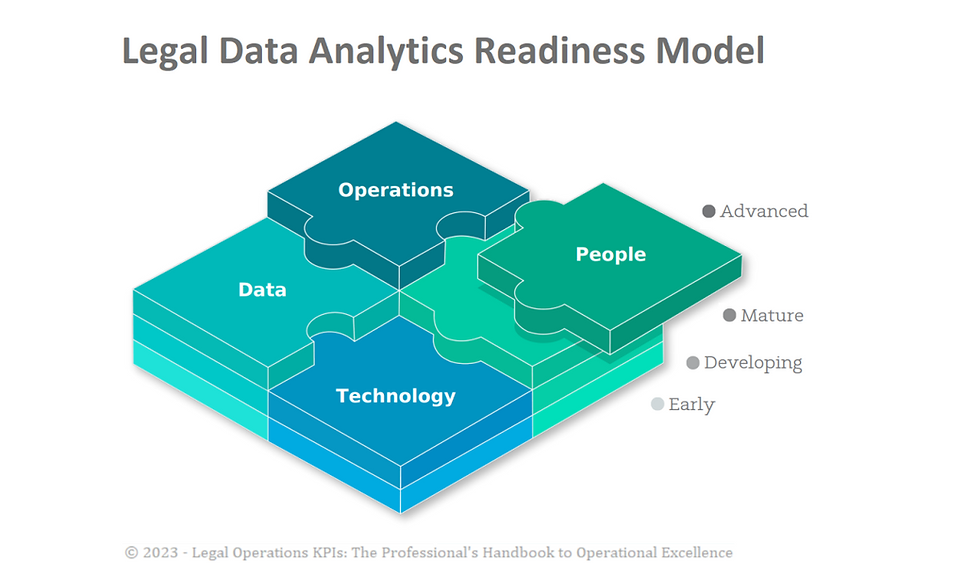Got a List of KPIs & Ready to Implement?
- morikabiri
- Dec 15, 2023
- 3 min read

December 16, 2023
Are you a Legal Operations professional planning to use data for decision-making? You might have a list of Key Performance Indicators (KPIs) and reports but are uncertain about which ones to prioritize and how to implement them effectively. This is a common challenge. A necessary approach is to avoid overpromising; instead, focus on setting achievable goals and progressing step-by-step. Data analytics is complex, requiring a strategic approach. Having a list of KPIs is not enough; prioritization and understanding how to implement them effectively and sustainably is also needed.
Legal Data Analytics Readiness Model
Data analytics transcends specific technology or tools; it's the process of transforming raw data into actionable insights. Achieving this can involve a range of technological solutions and methodologies, making data analytics a comprehensive science. The goal of this model is two-fold: to assess your current readiness level and to select metrics and indicators aligned with your readiness. This enables not only measurement but also the creation of a roadmap for KPI implementation and use in management and decision-making.
This evaluation assigns each area a rating from 1 to 4, representing readiness levels from Early to Advanced. Maturity is broken down into four areas: People, Operations, Technology, and Data. An example KPI and its categorization across these areas and levels will be discussed.
What are the Levels of Maturity?
To acknowledge the progressive stages, let’s divide readiness into four distinct levels:
Early (Level 1) - Legal departments at this stage react to issues as they arise, lacking structured data analytics and minimal technology use. To improve, they should invest in data analytics training, establish data management processes, and adopt case management software.
Developing (Level 2) - Departments implement technology, standardize processes, and use data for proactive measures and operational efficiency, moving towards data-driven decisions.
Mature (Level 3) - With a structured approach and a dedicated data analytics team, these departments integrate data insights into decision-making, optimize workflows, and use advanced technology for strategic planning.
Advanced (Level 4) - At this peak stage, legal departments significantly contribute to business goals through predictive analytics, advanced visualization, and AI, influencing company-wide strategies with their insights.
What Are the Key Areas of Maturity?
The key areas of maturity represent the pillars on which a legal department can build and enhance its data analytical capabilities and provide a framework for assessing where you currently stand and what needs to be developed.
People - Assess the competencies of the legal and IT teams, focusing on technical skills, adaptability, leadership, and communication, to ensure effective use of data analytics.
Operations - Evaluate the efficiency of legal processes and workflows, management of data in cases and documents, communication effectiveness, and compliance protocols, considering their integration with other departments and contribution to organizational goals.
Technology - Examine the utilization and integration of technology tools to enhance legal operations' efficiency, reduce manual tasks, and support data-informed decision-making.
Data - Analyze the quality, accessibility, and use of data for strategic decision-making, including the sophistication of analysis techniques and the impact of data-driven insights on legal strategies and outcomes.
Real-World Example
Let's examine the KPI Matter Average Age (MAA) and the suggested minimum readiness level needed for its implementation.

People (Level 2) - Requires understanding of matter management and legal operations life cycles to effectively use MAA data in legal operations.
Operations (Level 3) - Emphasizes structured processes for case management, including uniform criteria for case lifecycle, to ensure consistent MAA calculation.
Technology (Level 2) - Utilizes matter management systems and reporting tools for efficient MAA reporting, minimizing manual errors and offering detailed insights for improved decision-making.
Data (Level 3) - Necessitates high-quality, accurate data for precise MAA calculation, noting challenges like delayed case closures that may affect accuracy.
The Matter Average Age demonstrates the importance of readiness across key areas: understanding legal processes (People Level 2), having structured case management (Operations Level 3), using technology for efficient reporting (Technology Level 2), and ensuring data quality for accuracy (Data Level 3). This example underlines the need for a multidimensional approach to effectively implement and leverage KPIs within legal operations.
Measuring Readiness
Determining your position within the Legal Data Analytics Readiness Model is critical for strategically implementing relevant KPIs. Aligning legal operations with the organization's wider goals facilitates continuous improvement and long-term success. To evaluate your current level of readiness in legal data analytics, a readiness assessment tool has been developed.
See this article on Linkedin here.
Got any questions? You can contact us at info@infiniglobe.com or (833) LGL-TECH.


